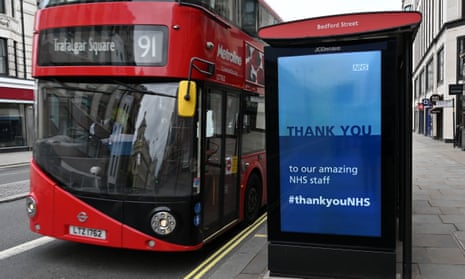An extra £2bn of state aid will be needed to keep London’s transport system running until September, senior industry sources have told the Guardian.
Transport for London has asked for the emergency funds because its revenue stream has been devastated by the coronavirus lockdown.
Both TfL and the Department of Transport declined to comment on the proposed £2bn rescue package.
Senior industry sources confirmed that TfL and its transport commissioner had called for the cash injection to help keep buses, tube trains and light rail systems functioning until early autumn.
They said TfL was seeking at least £2bn in the short-term to ensure there is a transport system to cope with millions of workers returning to jobs once the lockdown is relaxed.
A TfL spokesperson said the near total lack of fares in lockdown had “devastated our revenue”. They continued: “We have been very clear with the government that we are going to need new support, a new grant to get us through the next period and also in the longer-term.”
The spokesperson said that prior to the pandemic the transport system in London had been “on the way to self-sufficiency” in terms of passenger demand and income streams.
As well as no income from fares, TfL has also lost revenue after it suspended all rent it charges to tenant business units inside London’s rail, bus and tube stations.
According to TfL figures it costs around £600m a month to run the capital’s transport system.
A spokesperson for the Department of Transport said: “We continue to work closely with Transport for London and the mayor’s office to help face the challenges affecting TfL as a result of the Covid-19 outbreak.”
The union representing the majority of bus workers in London said it believed TfL would also seek a further£2bn in state aid after September to maintain the capital’s transport until the end of the year.
Unite blamed the hole in TFL’s finances partly on the lockdown but also on the withdrawal of hundreds of millions in state subsidies that were pumped into London transport until the mid-2000s.
TfL and Unite said passenger footfall on London’s buses was down 85% since the pandemic began. TfL said the numbers using the tube had declined by 95%.
With most buses allowing travellers to enter on side doors only to protect drivers at the front from infection, the bus network’s income stream has been further reduced.
The union said 31 bus workers had died from Covid-19.
Pete Kavanagh, Unite’s London and eastern regional secretary, called on TfL and the Department of Transport not to address the hole in the bus system’s finances by making redundancies.
“After lockdown, more than ever the people of this city will want a fully functioning bus network. I believe that the community will join our staff in resisting any move to reduce the number of bus workers,” he said.
“Most people are showing great solidarity with our colleagues who take other key workers to places like hospitals in this crisis. I am sure they will stand by the bus workers in the face of any threatened job losses,” he said.
Kavanagh added: “We need a properly funded, further electrified, cleaner, greener bus system now more than ever, and especially after the lockdown is over. The fact that prior to the pandemic 6 million Londoners used the buses alone shows that a demand is there for a top-grade bus network in the capital.”
